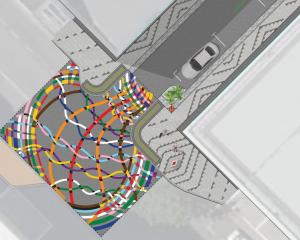
Dr Griffin, who is also Otago Museum director, praised the ''beautiful'' images not only of Pluto but also of its relatively large moon, Charon.
He was ''very excited'' over what was going to be learned over the next few days, weeks and months.
''It's incredible the data we're getting.''
This was a golden era for exploration of the solar system, and the information gleaned from New Horizons would transform our knowledge, he said.
The unmanned spacecraft passed within 12,500km of the dwarf-planet at midnight on Tuesday, after a journey of more than 4.8 billion km over more than nine years.
The closest images seen from the space probe so far were taken at a distance of more than 760,000km, but they have already wowed scientists, showing Pluto has a Mars-like reddish hue.
They also revealed Pluto's crater-covered landscape and an enigmatic blue heart-shaped feature on its surface which has already taken off on the internet.
Data sent back from near Pluto, even travelling at the speed of light, takes more than four hours to return to Earth.
Dr Griffin said it was an incredible technological achievement to capture and return the images of these seemingly dim and distant objects to Earth, given the sheer distances involved.
Fierce debate has continued in some quarters about whether Pluto should be reinstated to classification as a full planet.
This debate was likely to continue at a meeting of the International Astronomical Union (IAU) in Hawaii next month, he said.
The space probe carries some of the ashes of Clyde Tombaugh, an American astronomer who discovered Pluto in 1930.
Pluto was redesignated by the IAU as a dwarf planet in 2006, within months of the New Horizons spacecraft leaving Earth.
Nasa chief administrator Charles Boden said recently he hoped scientists would reconsider the dwarf planet classification and added: ''I call it a planet''.
Dr Griffin appreciated the value of the discussion about Pluto's planet status, but said Pluto's relatively small size - smaller than Earth's Moon-raised questions about restoring Pluto's full planet status.
The argument might then run that other sizeable objects in the distant Kuiper Belt could then also be classified as planets, he said.
Dr Griffin, who has a PhD in astronomy, has contributed to the observation and study of a binary asteroid system, known as 1998 WW31, in the Kuiper Belt, and has named several main belt asteroids.
Learning more about Pluto also shed more light on the nature of the Kuiper Belt asteroids, including some binary asteroids that operated in a somewhat similar way to Pluto and Charon, he said.
He hoped the new observations of Pluto would also ultimately help clarify the origins of Pluto, Charon and its other moons.
If subsequent analysis suggested their composition was similar to each other, that could suggest there may have been an earlier collision that split some of the orbiting material apart.
But if the composition of Pluto and Charon was found to be significantly different, that would suggest possible alternative explanations for how they came into being.
Prof Craig Rodger, a University of Otago physicist, is undertaking space-related research involving solar terrestrial physics, at Iowa University, in the United States, on a Fulbright New Zealand Scholar Award.
The Pluto fly-by was an emotional moment for all of those excited and inspired by the exploration of the solar system, Prof Rodger said.
This was not the end of exploration of the solar system but was another step. It was confirmation that such exploration was continuing, despite economic and political pressures.
Dr Griffin has previously served as head of public outreach at the Space Telescope Science Institute, which operates on behalf of Nasa in Baltimore, in the United States.












